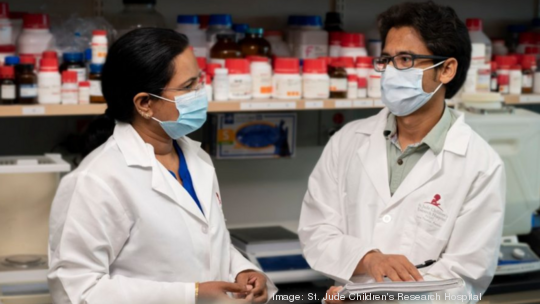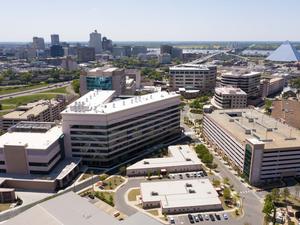
Interferon (IFN)-based therapies are usually considered effective in helping the body’s immune system eliminate viruses and treat viral infections.
So when COVID-19 hit, IFN therapy was considered a solution to combat the deadly impact of the virus. However, when used to treat patients with established SARS-CoV-2 infections, that therapy demonstrated limited efficacy and, in some instances, even increased mortality.
Until now, the underlying mechanisms behind the detrimental impact of IFN therapies on COVID-19 patients were unclear, but scientists at St. Jude Children’s Research Hospital made headway and found the gene responsible for the damaging results in these patients.
IFN therapy efficacy
According to a paper published May 19 in Science Immunology, St. Jude scientists found that ZBP1, an innate immune sensor, and its associated inflammatory cell death pathway, PANoptosis, are “major contributors" to the adverse impact of interferon treatment in patients with coronavirus.
“Our study improves our fundamental understanding of innate immunity and inflammatory cell death pathways and shows how modulating these processes during coronavirus infection could be used to improve patient outcomes,” corresponding author Thirumala-Devi Kanneganti, Ph.D., St. Jude Department of Immunology vice chair, said in a release.
Kanneganti and her group have studied the ZBP1 gene and its role in cell death for many years. Initially, the group identified ZBP1 as an innate sensor of the influenza virus that triggers the inflammatory cell death pathway, PANoptosis, and have now identified its impact on patients with established COVID-19 infection.
“Interferons induce the expression of interferon-stimulated genes. Some of these genes show antiviral function while some drive cell death,” Kanneganti said. “One such interferon-stimulated gene is ZBP1. Interferon induces robust expression of ZBP1, which can then sense SARS-CoV-2 and drive inflammatory cell death. This cell death is detrimental for patient outcomes.”
To identify the gene responsible for such cell death, scientists used a CRISPR-Cas9 screen, a unique technology that helped remove the genes in macrophages infected with the coronavirus. Upon studying the surviving cell, they could identify the missing gene and link it with cell death. The gene identified through this screening method was ZBP1.
According to the release, when this gene was removed in COVID-19 infected mice, they found it prevented cell death and mortality during interferon therapy.
“Inhibiting ZBP1 activity may improve the efficacy of IFN therapy, paving the way for the development of new and critically needed therapeutics for COVID-19 as well as other infections and inflammatory conditions where IFN-mediated cell death and pathology occur,” the authors wrote in their study.
Cytokine storm link
Not only did the researchers identify that ZBP1 drives cell death in COVID-19 patients treated with interferon, but they also recorded how it could lead to a cytokine storm, which has been known to cause organ damage in COVID patients and result in fatality.
Interferons sense viral infections and activate an antiviral inflammatory response to combat these infections. As part of the response, it also drives up the levels of certain interferon-stimulated genes like ZBP1 that cause cell death to prevent the infection from spreading. The release said that this response becomes uncontrolled in patients with poor outcomes.
The cell death leads to the production of powerful immune signaling molecules — cytokines — which cause more cell death. This cascades into a cytokine storm responsible for detrimental results, including multi-organ failure.
When coronavirus-infected mice were treated with interferon, cell death was accompanied by a cytokine storm. Deleting the ZBP1 gene in the COVID-infected mice prevented cell death and mortality during interferon therapy.
“It appears inflammatory cell death can be beneficial if it occurs in the early phase of infection,” said co-first author Rajendra Karki, Ph.D., St. Jude Department of Immunology. “However, once the infection is established, the ZBP1-mediated PANoptosis, inflammatory cell death mechanism promoted by interferon therapy becomes detrimental by resulting in cytokine storm, inducing tissue damage, morbidity, and mortality.”








